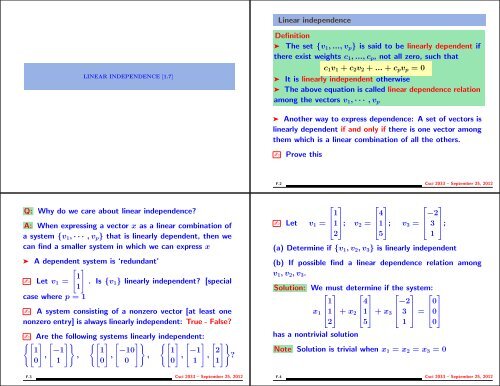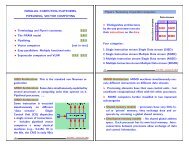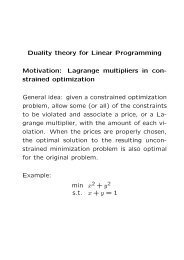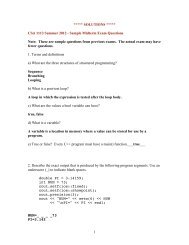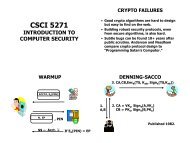Linear independence Definition ® The set {v 1, ..., vp} is said to be ...
Linear independence Definition ® The set {v 1, ..., vp} is said to be ...
Linear independence Definition ® The set {v 1, ..., vp} is said to be ...
Create successful ePaper yourself
Turn your PDF publications into a flip-book with our unique Google optimized e-Paper software.
LINEAR INDEPENDENCE [1.7]<br />
Q: Why do we care about linear <strong>independence</strong>?<br />
A: When expressing a vec<strong>to</strong>r x as a linear combination of<br />
a system {v1, · · · , <strong>vp</strong>} that <strong>is</strong> linearly dependent, then we<br />
can find a smaller system in which we can express x<br />
➤ A dependent system <strong>is</strong> ‘redundant’<br />
<br />
✍ Let v1 =<br />
1<br />
1<br />
. Is {v1} linearly independent? [special<br />
case where p = 1<br />
✍ A system cons<strong>is</strong>ting of a nonzero vec<strong>to</strong>r [at least one<br />
nonzero entry] <strong>is</strong> always linearly independent: True - False?<br />
✍ Are the following systems linearly independent:<br />
<br />
1<br />
0<br />
,<br />
−1<br />
1<br />
,<br />
1<br />
0<br />
,<br />
−10<br />
0<br />
,<br />
1<br />
0<br />
,<br />
−1<br />
1<br />
,<br />
2<br />
1<br />
?<br />
F-3 Csci 2033 – Septem<strong>be</strong>r 25, 2012<br />
<strong>Linear</strong> <strong>independence</strong><br />
<strong>Definition</strong><br />
➤ <strong>The</strong> <strong>set</strong> {v1, ..., <strong>vp</strong>} <strong>is</strong> <strong>said</strong> <strong>to</strong> <strong>be</strong> linearly dependent if<br />
there ex<strong>is</strong>t weights c1, ..., cp, not all zero, such that<br />
c1v1 + c2v2 + ... + cp<strong>vp</strong> = 0<br />
➤ It <strong>is</strong> linearly independent otherw<strong>is</strong>e<br />
➤ <strong>The</strong> above equation <strong>is</strong> called linear dependence relation<br />
among the vec<strong>to</strong>rs v1, · · · , <strong>vp</strong><br />
➤ Another way <strong>to</strong> express dependence: A <strong>set</strong> of vec<strong>to</strong>rs <strong>is</strong><br />
linearly dependent if and only if there <strong>is</strong> one vec<strong>to</strong>r among<br />
them which <strong>is</strong> a linear combination of all the others.<br />
✍ Prove th<strong>is</strong><br />
F-2 Csci 2033 – Septem<strong>be</strong>r 25, 2012<br />
✍ Let<br />
⎡ ⎤<br />
1<br />
⎢ ⎥<br />
v1 = ⎣1⎦;<br />
⎡ ⎤<br />
4<br />
⎢ ⎥<br />
v2 = ⎣1⎦;<br />
⎡ ⎤<br />
−2<br />
⎢ ⎥<br />
v3 = ⎣ 3 ⎦;<br />
2<br />
5<br />
1<br />
(a) Determine if {v1, v2, v3} <strong>is</strong> linearly independent<br />
(b) If possible find a linear dependence relation among<br />
v1, v2, v3.<br />
Solution: We must determine if the system:<br />
⎡ ⎤ ⎡ ⎤ ⎡ ⎤ ⎡ ⎤<br />
1 4 −2 0<br />
⎢ ⎥ ⎢ ⎥ ⎢ ⎥ ⎢ ⎥<br />
x1 ⎣1⎦<br />
+ x2 ⎣1⎦<br />
+ x3 ⎣ 3 ⎦ = ⎣0⎦<br />
2 5 1 0<br />
has a nontrivial solution<br />
Note Solution <strong>is</strong> trivial when x1 = x2 = x3 = 0<br />
F-4 Csci 2033 – Septem<strong>be</strong>r 25, 2012
Augmented syst:<br />
1 4 −2 0<br />
1 1 3 0<br />
2 5 1 0<br />
Echelon 1st step<br />
1 4 −2 0<br />
0 −3 5 0<br />
0 −3 5 0<br />
➤ Th<strong>is</strong> system <strong>is</strong> equivalent <strong>to</strong> original one.<br />
Echelon 2nd step<br />
1 4 −2 0<br />
0 −3 5 0<br />
0 0 0 0<br />
➤ Select x3 = 3 (<strong>to</strong> avoid fractions) and back-solve for x2<br />
(x2 = 5), and x1, (x1 = −14)<br />
➤ Conclusion: there <strong>is</strong> a nontrivial solution<br />
➤ NOT independent<br />
(b) <strong>Linear</strong> dependence relation: From above,<br />
−14v1 + 5v2 + v3 = 0<br />
F-5 Csci 2033 – Septem<strong>be</strong>r 25, 2012<br />
LINEAR MAPPINGS [1.8]<br />
Note: Text uses the reduced echelon form instead of backsolving<br />
[result <strong>is</strong> clearly the same. Both solution are OK]<br />
➤ With the reduced row echelon form<br />
1 0 14/3 0<br />
0 1 −5/3 0<br />
0 0 0 0<br />
➤ x1 = −(14/3)x3; x2 = (5/3)x3<br />
➤ select x3 = 3 then x2 = 5, x1 = 14<br />
➤ Recall: x1, x2 are basic variables, and x3 <strong>is</strong> free<br />
F-6 Csci 2033 – Septem<strong>be</strong>r 25, 2012<br />
Introduction <strong>to</strong> linear mappings [1.8]<br />
➤ A transformation or function or mapping from R n <strong>to</strong> R m<br />
<strong>is</strong> a rule which assigns <strong>to</strong> every x in R n a vec<strong>to</strong>r T (x) in<br />
R m .<br />
➤ R n <strong>is</strong> called the domain<br />
space of T and R m the<br />
image space or co-domain<br />
of T .<br />
➤ Notation:<br />
T : R n −→ R m<br />
R n<br />
●<br />
x<br />
Domain<br />
➤ T (x) <strong>is</strong> the image of x under T<br />
T<br />
R m<br />
●<br />
Range<br />
T(x)<br />
Image / Codomain<br />
F-8 Csci 2033 – Septem<strong>be</strong>r 25, 2012
Example: Take the mapping from R 2 <strong>to</strong> R 3 :<br />
T : R 2<br />
x =<br />
<br />
x1<br />
x2<br />
<br />
−→ R 3<br />
⎡<br />
⎢<br />
−→T (x) = ⎣<br />
x1 + x2<br />
x1x2<br />
x 2 1 + x2 2<br />
Example: Another mapping from R 2 <strong>to</strong> R 3 :<br />
T : R 2<br />
x =<br />
<br />
x1<br />
x2<br />
<br />
−→ R 3<br />
−→T (x) =<br />
⎡<br />
⎢<br />
⎣<br />
x1 + x2<br />
x1 − x2<br />
x1 + 5x2<br />
✍ What <strong>is</strong> the main difference <strong>be</strong>tween these 2 examples?<br />
F-9 Csci 2033 – Septem<strong>be</strong>r 25, 2012<br />
➤ Given an m × n matrix A Consider the special mapping:<br />
T :R n −→R m<br />
x −→y = Ax<br />
✍ Domain == ??; Image space == ??<br />
➤ From what we saw earlier [‘Properties of the matrixvec<strong>to</strong>r<br />
product’] such mappings are linear<br />
➤ As it turns out:<br />
Any linear mapping can <strong>be</strong> represented in matrix form<br />
➤ Th<strong>is</strong> means that if T <strong>is</strong> linear, there ex<strong>is</strong>ts a matrix A<br />
such that T (x) = Ax for all x in R n .<br />
➤ A <strong>is</strong> the representation of T .<br />
F-11 Csci 2033 – Septem<strong>be</strong>r 25, 2012<br />
⎤<br />
⎥<br />
⎦<br />
⎤<br />
⎥<br />
⎦<br />
<strong>Definition</strong> A mapping T <strong>is</strong> linear if:<br />
(i) T (u + v) = T (u) + T (v) for u, v in the domain of T<br />
(ii) T (αv) = αT (u) for all scalars α and all u in the<br />
domain of T<br />
➤ <strong>The</strong> mapping of the second example given above <strong>is</strong> linear<br />
- but not for the first one.<br />
➤ If a mapping <strong>is</strong> linear then T (0) = 0<br />
Observation: A mapping <strong>is</strong> linear if and only if<br />
T (αu + βv) = αT (u) + βT (v)<br />
for all scalars α, β and all u, v in the domain of T .<br />
F-10 Csci 2033 – Septem<strong>be</strong>r 25, 2012<br />
✍ Let A <strong>be</strong> a square matrix. Is the mapping x → x + Ax<br />
linear? If so find the matrix associated with it.<br />
✍ Same questions for the mapping x → Ax + αx - where<br />
α <strong>is</strong> a scalar.<br />
✍ Express the following mapping from<br />
R 3 <strong>to</strong> R 2 in matrix/vec<strong>to</strong>r form:<br />
➤ Is th<strong>is</strong> a linear mapping?<br />
y1 = 2x1 − x2 +1<br />
y2 = x2 − x3 −2<br />
✍ Read Section 1.9 and explore the notions of on<strong>to</strong> mappings<br />
(‘surjective’) and one-<strong>to</strong>-one mappings (‘injective’)<br />
in the text. You must at least know the definitions.<br />
✍ A mapping <strong>is</strong> on<strong>to</strong> if and only if ....<br />
✍ A mapping <strong>is</strong> one-<strong>to</strong>-one if and only if ....<br />
F-12 Csci 2033 – Septem<strong>be</strong>r 25, 2012


